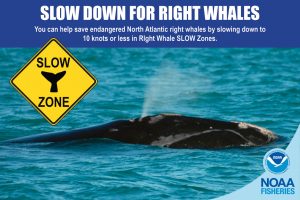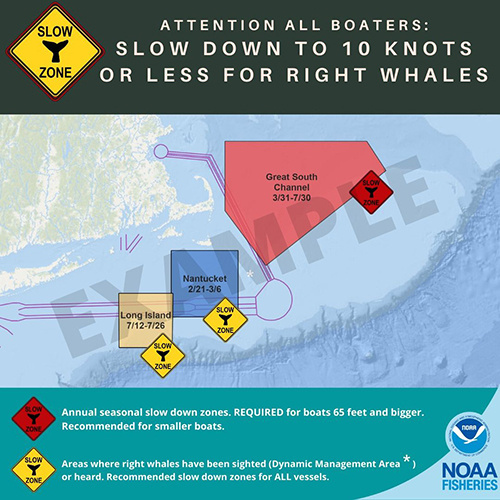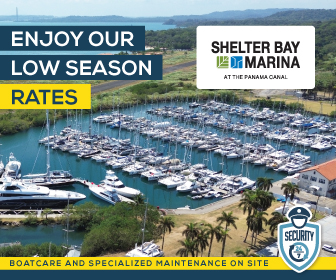North Atlantic: Help Endangered Whales – Slow Down in Slow Zones
NOAA began appealing to Boaters back in 2020 to help save critically endangered Right Whales by launching a Slow Zones Campaign in US waters from Maine to Virginia. The death toll of Right Whales continues to surge at an alarming rate with the latest tragedy a one-year-old calf found dead off the coast of Georgia in February 2024.
Published 5 years ago, updated 1 year ago


Update February 2024: The tragic death of a one-year-old calf is the latest in a horrific trend. Just last month, a newborn Right Whale calf was maimed by a boat off the coast of North Carolina. Earlier this month, a three-year-old female washed up dead on the shores of Martha’s Vineyard, after being entangled in fishing gear for more than half of her short life. Of the 17 North Atlantic Right Whale babies born this season, three are not expected to live and five North Atlantic Right Whales have been found dead, seriously injured, or missing since mid-December. For a species with only around 356 whales remaining, this year’s rising death toll is alarming. Find out how you can help below.
Right Whales at Risk
North Atlantic Right Whales are one of the world’s most endangered large whale species. With their population numbering only around 400 animals, the population is in decline. Vessel collisions (strikes) are one of the major threats that these animals face. NOAA’s Right Whale Slow Zones asks vessel operators to get involved in reducing the risk of vessel strike in U.S. waters.
Any sized vessel can present a problem if it strikes a whale. A vessel can leave an injured whale with wounds that make it vulnerable to other threats or even cause its death. This season alone, two calves have been struck by vessels in U.S. waters. One calf has not been sighted since it was struck by a boat in mid-January off the coast of Georgia. The other was found dead off the coast of New Jersey in June with evidence of multiple vessel strikes. Early evidence suggests that small vessels may have been involved in at least one of these collisions. These recent losses remind us that more needs to be done to reduce the risk of vessel strike to right whales.
Right Whale Slow Zones
Through the new Slow Zones campaign, NOAA are mapping and providing coordinates to vessel operators indicating areas where right whales have been detected. Right Whale Slow Zones can occur in waters from Maine through Virginia.
Using “Sound” Science to Protect a Species
The Slow Zones program uses sound collected from underwater acoustic listening devices to detect right whales. These scientific data, in addition to visual sightings, allow NOAA to be more proactive in addressing the risks all boats pose to right whales. It enables them to better notify researchers, managers—and now all boaters—of the presence of right whales in the area.
Why Does Speed Matter?
Boats of any size can kill a whale if a collision occurs. Sometimes the death does not occur immediately, but can impair the animal’s health or behavior. This makes it susceptible to infection, or—in the case of this latest calf’s death—additional vessel strikes. Going slower (10 knots or less) allows you to keep a close eye out for right whales and other protected species. If a strike does occur, reducing your speed will lower the chances of it being a fatal collision for the whale.
Why Should Small Boaters Care?
Given the precarious state of the right whale population, every whale saved has a big impact on the species’ longer term survival. Small- and medium-sized boats can pose a threat to right whales, so your actions can help avoid these disasters.
For small boaters, colliding with a whale can be especially dangerous for passengers and destructive to your vessel. Given how difficult right whales can be to spot from the water, slowing down in these zones helps keep everyone safe.


You Can Make a Difference for Right Whales
- Sign up for our Right Whale Slow Zone notifications and go slow in or avoid any areas where right whales have recently been sighted or heard. Select “Right Whale Slow Zones” under the Regional New England/Mid-Atlantic subscription topics.
- Report right whale sightings. Please report all right whale sightings from Virginia to Maine to (866) 755-6622. Right whale sightings in any location may also be reported to the U.S. Coast Guard via channel 16 or through the WhaleAlert mobile app.
- You can check for Right Whale Slow Zones on NOAA’s online right whale sightings map. You can also download the free Whale Alert app, which will automatically notify you when you enter one of these areas.
- Keep your distance if you see a right whale. Federal regulations require boats, aircraft (including drones), people using other watercraft such as surfboards, paddleboards, kayaks, and jet-skis, and divers and snorkelers to stay at least 500 yards away from North Atlantic right whales.
- Know where the annual and predictable Seasonal Management Areas are located and go SLOWLY (10 knots or less) in season when boating in these areas.
- You can also follow NOAA on Facebook (@NOAAFisheriesNEMA) and Twitter (@NOAAFish_GARFO) for announcements.
- Spread the word about Right Whale Slow Zones to boaters by sharing social media messages and alerts.
Read full NOAA report with images at here.
Full details about the North Atlantic Right Whale can be found at https://www.fisheries.noaa.gov/species/north-atlantic-right-whale
Related to following destinations: East Coast (USA), Hampton (Virginia), Portland (Maine), USA
Related to the following Cruising Resources: Atlantic Ocean West, Citizen Science, Environment, Routing




